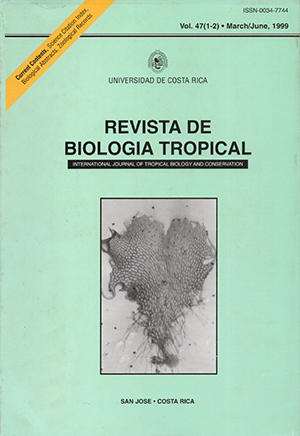Abstract
The chaetognaths of the Campeche Bank were studied in April-May, 1986. Organisms were collected at 24 sampling stations with bongo trawls. The taxonomical identity of the specimens collected was determined with basis on McLelland’s key and descriptions. We calculated density (expressed as a number of organisms per 100m3), frequency of occurrence and Importance Value (as the sum of relative density and frequency) for each species and species richness for each sampling station. Adendrogram of sampling stations was constructed using the Morisita`s similarity index and the unweighted pair-group method that uses arithmetic means. Twelve species were recorded. The highest species richness was found at sampling stations located near the continental slope, whereas only one or two species were recorded at the Campeche Sound. Flaccisagitta enflata was the most abundant and widely distributed species in the study area; Sagitta tenuis was the second most abundant species and it ocurred in 79% of the sampling stations. Krohnitta pacifica and Flaccisagitta lyra were the least frequent species. The highest density of quetognaths (>5 000 organisms/100m3) was recorded at some stations located at the Campeche Sound; values from 1 000 to 5 000 orgs./100m3 were recorded in the Western part of the Yucatan Peninsula. Three species groups could be recognised with basis on the species` Importance Values: The first group (IV:> 75) includes F. enflata, S. tenuis, Ferosagitta hispida, K. subtilis and Serratosagitta serratodentata. The second group (IV:>36) comprises four species and the third group (IV:<15) includes the least frequent and abundant species Mesosagitta decipiens, K. pacifica and Flaccisagita lyra. From the dendrogram constructed from the Morisita`s similarity index, five groups of sampling stations were distinguished. The first group included two stations located off the Northern part of the continental slope, where M. minima was the dominant species and the Simpson`s dominance index reached its lowest value (0.215). Most of the species recorded in these stations have an oceanic distribution. The second group comprised seven stations located near the upwelling zone, where F. enflata coexists with five to nine other species and the Simpson`s dominance index had an intermediate value (0.243). The species recorded in these stations have an essentially oceanic distribution and occur northwards from Cabo Catoche. The third group included 10 stations, most of which were located westward from the Campeche Sound and another one in the Yucatan Channel. In these stations F. enflata was the dominant species and the Simpson`s index reached its highest value (0.683). The fourth group included one station located in the upwelling zone, were the dominance index has its lowest value and S. serratodentata was the dominant species. The fifth group included coastal stations where F. enflata was the dominant species and the Simpson`s index reached high values. The most important characteristics of the study area during this period were: 1. Two distinct zones. The Campeche Sound in the Western part of the area and the Northern coastal stations, where F. enflata was the dominant species and the Simpson`s dominance index reached its highest values, and the oceanic Northern zone off the Yucatan Peninsula where F. enflata had low abundance and there was a higher abundance and diversity of other chaetognath species. 2. F. enflata, S. tenuis, F. hispida and K. subtilis were the dominant chaetognath species.##plugins.facebook.comentarios##

This work is licensed under a Creative Commons Attribution 4.0 International License.
Copyright (c) 1999 Revista de Biología Tropical
Downloads
Download data is not yet available.


